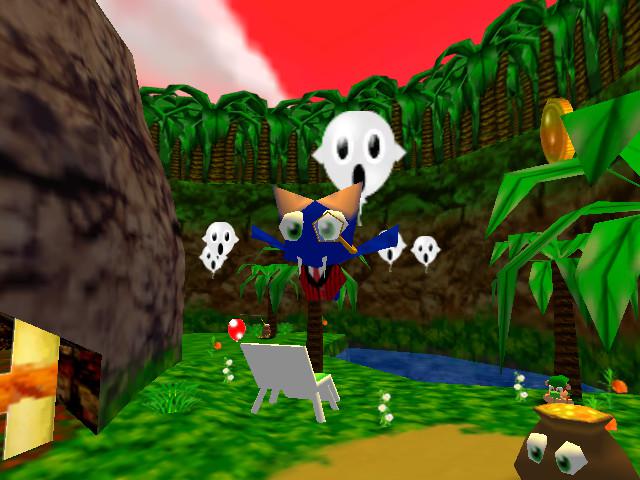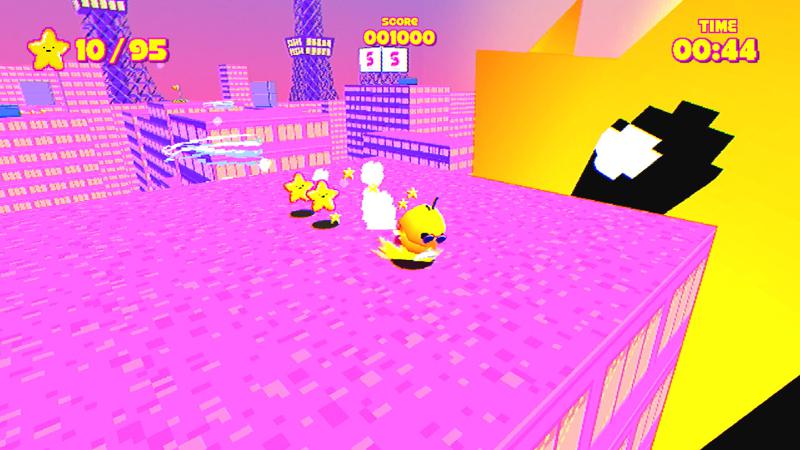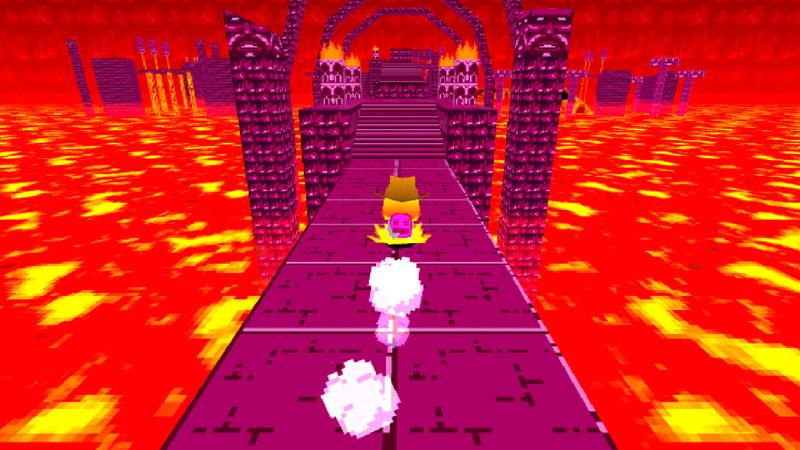Itch.io have for the past few years released some mindbogglingly worthwhile bundles, some containing upwards of a thousand games, and like pretty much everyone who bought them, the vast majority of the games inside the bundles remain unplayed, or even unseen. It’s hard enough wrestling with a bulging Steam library, overflowing physical collection and ever-expanding Game Pass selection, add on top thousands of obscure indies which have no official (but plenty of unofficial) means of sorting them it’s easy to get overwhelmed.
I saw Macbat 64 in a list of “best Itch.io bundle games” and thought it looked cute. Nostalgia bait is sometimes something you just have to succumb to and spend a few minutes reminiscing; my yearly Oblivion playthrough which only makes me pick up on its many flaws is testament to that. So with that I decided to shine a spotlight on that particular developers output, the platformers specifically, as they, Siactro, have also developed some non-platformers and I was in a jumpy mood.
There’s four or five (depending on how you count it) in total, and they’re all incredibly short and as such I’ve been quite concise with each of them. Since I started with Macbat 64, we’ll start with that, hopping back to Kiwi 64 after, and finally leapfrogging back to Toree 3D and Toree 2. It’s a metaphor for platforming or something, promise…
Macbat 64
In my recent review for Tainted Grail: Conquest, I touched on the ubiquitous idiom of judging a book by its cover. I both fairly and unfairly judged that game on initial impression, turning out exactly how I expected it to yet with flavours I was completely surprised by.
If my summation in that review was to not judge a book by its cover, I take it all back for Macbat 64, a game which so blatantly and succinctly illustrates what it’s all about I barely have to write anything about it. The developer themselves, Siactro, have no problem advertising themselves as a creator paying homage to the innocent fun of the 90’s, and in that way, Macbat 64 is perfect.
Harmless would be a better word critically speaking, as for a complete game it’s lacking many areas. It’s a terse experience, which ends up working in its favour given the rudimentary mechanics at play. It’s ostensibly a 3D platformer, a collectathon specifically, and a Banjo-Kazooie love letter at its very core, albeit one with an attention deficit disorder, fluttering occasionally to other genres to pay its brief respects. A kart racer one second, 2D platformer the next. The tunes are bubbly when they need to be, sombre when they need to be too, and while none of it is exactly Grant Kirkhope level, it’s perfectly fine for what it’s trying to do.

The actual platforming seems trivial, and to beat a dead horse, it’s competent, and unlike many early 3D platformers, never manages to frustrate you with crappy camera controls or sluggish movement. In fact, the platforming is so trivial I’m not sure how content I am calling it a 3D platformer. It seems a bit misleading when so much of it is just an expression of thanks for a time well missed.
In short, judge Macbat 64 by its cover. You will know if it’s worth anything to you, and at worst you experience a completely inoffensive passionate reference to something you (sadly) missed. At best? Grant Kirkhope cameo as a monkey.
Kiwi 64
Playing Kiwi 64 after Macbat 64, I expected something which resembled the latter, condensed, and largely cheaper feeling. It was a nice surprise then that Kiwi 64, while incredibly brief and unrefined, was arguably even more charming than its successor, more rigorously paying homage to the Rare output on the Nintendo 64 with delightful accuracy.
This is admittedly in part due to the one-song soundtrack accompanying the game, which so closely resembled Banjo & Kazooie that I thought Grant Kirkhope himself had jumped on the project. It is in fact part of a fan album produced by Jay Moser titled “Bear and Bird”, the song here resembles that chipper, boppy music you’d expect at the foot of Spiral Mountain. I can’t sell its calibre enough, utilising the same crunchy quality found in N64 games to evoke that nostalgia, piling on whimsical xylophones and resonant trumpets to match the energy of the games we cherish.

As you can expect, the few characters found in the world talk with that disjointed chirp and in equal part look like they’d exist in the worlds it pays respects to with talking oak trees, collectible grapes and poetic, dastardly melon. Kiwi themselves exude character, notably in the same way Kazooie does when using her to sprint across the level, instead replacing incessant kazoo noises with the pitter-patter of their feet.
All of it looks the part, which is to say it’s markedly dated and none of it really makes sense. We’re tasked with collecting a few items, notes and genie bottles, and some of our assorted characters give us menial collect-a-thon tasks to do in the nonsensical world we’re trying to navigate. I say “trying”, but it’s effortless really, both in the sense it controls well, and that there’s not really much in the way of inhibitions. We have an attack we use like twice, a jump we use a lot more than twice and that’s your lot.
I think I prefer Kiwi 64 to Macbat 64 in a way. There’s no pretence of a proper game under the hood, and it wholeheartedly feels like nothing more than a homage. It’s very brief and elicits a smile, what more could you want out of something like this?
Toree 3D + Jumbled Jam
“A bite-sized 3D Platformer with a few weird elements” says the game’s store description, and in all regards it’s true. But let’s break that down a bit…
I think if you talk about platformers to someone on the outskirts of video games, they might name two franchises in particular: Mario, and Sonic. A monumental battle between two companies spawned two mascots, and thusly long standing video game series’, which saw its most gruesome skirmishes in the late 90’s. They stood for two different things in the end: Mario has precision and intricacy, while Sonic was all about speed and empowerment. Branching off both spawned subgenres and other successful names, notably Rareware delights such as Banjo & Kazooie and Conker’s Bad Fur Day, which with developer Siactro paid respects to with the previously mentioned Kiwi 64 and Macbat 64.
If Sega had made the leap into 3D with Sonic and developed a game which wasn’t total bollocks, something along the lines of Toree 3D would be it, perhaps a bit longer than this affair though, as Toree 3D’s “bite-sized” playtime clocks in at just under half an hour. But it is absolutely a “3D Platformer”, not in the same way Kiwi 64 or Macbat 64 were though. No, here, the platforming is front and centre, jostling with nostalgia and frivolous tribute to the front of the queue and doing so successfully.
But it’s also “weird”. Not too weird, sporadically proving odd and unsettling, and to my enjoyment, not often enough, as while with these peculiarities absent Toree 3D is still a stellar retro experience, it’s these flashes of the uncanny which proved worthy of supreme praise, and if taken further could have made Toree 3D something more than a retelling of history which never happened.
To put some flesh on the proverbial bones, Toree 3D is entrenched in late 90’s, early 2000’s clamour. It’s coated in neon pinks and purples to a degree which were the game longer might give you a headache. It’s evocative of a time I never fully experienced, and never truly miss. It’s the video game incarnation of a stereotypical American bowling alley: lights galore, Japanese-tinged DDR tunes blaring in the background and cutesy, “adorbs” imagery. I hate it, and it’s perfect, and to make something so alien to me so vivid and tangible is an accomplishment.
To complete the Sonic comparison, Toree 3D is a game you can take both slow and fast, and it’s manifest the game wants you to go fast. One of my problems with Sonic, specifically its lacklustre 3D outings, was just how bad it got this mantra of speed. It’s a hard thing to accomplish in 3D, and Sega clearly have not been up to the task, leading to momentary springs met with dead stops as you hit a wall or fly off stage. Toree 3D controls beautifully, hindered slightly by a stiff camera, but wholly functional and fun. It takes a different approach to the games before it by implementing a run button, allowing the player to blitz across terrain and leap through the air across platformers. The timer at the top right of the screen eggs us on, and I fell for the bait, taking any opportunity I could to hold the button and soar through the stage, sometimes ignoring the game’s collectible stars in favour of a cathartic thrill, which was the right choice given their superficial implementation.

The timer starts you off, but the music keeps you going, an agreeable balance between Monkey Ball-style techno, and saccharine pop and rock tunes which feel ripped straight from the early 2000’s. There’s zoomy strips, moving platforms and wind uplifts for some added verticality, and the game only really slows down at some poorly designed choke points, notably in the motorway-style levels where cars move in patterns and can lead to just waiting for them to align. Regardless, the nine levels here are varied in presentation and gameplay, some offering a brighter, more laidback experience, others – accelerated by a pumping electronic bop – feel made for speedrunning.
And then you get to the end of level four, segwaying into level five, and the self-described “weird” rears its head. Before this point, you see a choice few textures missing, replaced with binary code, which while conspicuous is believably part of the digital landscape. Stage four ends with a gurgling and sputter in the music, notably off kilter, followed by stage five which coats itself in the aesthetic of My Little Pony, cute, lively and blown out with colour, only to be subverted as you progress with some of the animated stars bobbing up and down in the sky change from their cheery disposition into a distorted, uncanny expression, drowning out the music almost entirely with static and prompting some genuine horror.
Unfortunately, it never comes, and the tension found in this level isn’t repeated thereon either. Hitherto that level, I was ready to write my review for the game, thinking I’d fully understood it and enjoyed it for what it was, and it pulled a quick one on me in the knick of time, reeled me back in, only to toss me back soon after. I can only get so much enjoyment out of a game of Toree 3D’s style for so long, and this is fully acknowledging how polished an experience it is. Compared to their prior work, Toree 3D stands resolute in its originality, even if it elicits comparisons to games of yore, and is thoroughly successful in what it aims to achieve. I need something else though. I’m not a speedrunner, and I like my platforming object-centric, and Toree 3D plays to neither of those preferences. So far it’s the game I can recommend more generally, and speaking to quality alone, it pips the previous two a fair bit. But it simply ain’t weird enough for my liking.
Which leads us fittingly and swiftly into a little expansion to the game, Jumbled Jam, a side project released after our next game, Toree 2, which doesn’t so much build upon Toree 3D as it does purposefully abandon it in favour of much tougher, more experimental challenges. It was created during the sequels development, and as such doesn’t make use of the mechanics we’ll discuss next, and instead manipulates level design alone as a means to bring out the latent difficulty found in Toree 3D’s engine.
It’s certainly more of a mouthful, transforming already existing nonsensical levels into something even more so, all clearly in the name of challenge, which isn’t what I was looking for. As such, I’m left with the same opinion, and this time round can appreciate the further concerted effort by level designer, Kalliros, to create something for a specific audience.
Siactro suggests you consider it the “obscure and forgotten Toree 3D romhack”, an apt summation, but not one that appeals to me a great deal.
Toree 2
I can’t say I’m disappointed with Toree 2, because by almost all accounts I think it’s a better game for the people it was made for, which Siactro describes as those wanting “fast gameplay” and “flow focussed levels”. Toree 2 is that, and almost makes Toree 3D look just as slow as Kiwi 64.
The addition of speed gates – green barriers which populate both air and land – make the game play even more like a good Sonic level, which I would describe as something which takes the reins and lets the euphoria of pure speed usher forth. Toree 2 does seem more difficult, and I died a few times as a result of taking the game at the breakneck speed it sets, but that further calcifies my belief that this game is an even better product for the speedrunning community.

For me though? No, it’s not a better game, as the brief moments of weirdness in the first game are diminished to a single event half way through the game. The gaudy, 90’s flavoured aesthetic doesn’t seem as potent here either, and the soundtrack, regardless of my opinion on the rest of the game, it notably less interesting and atmospheric, with each track spurring the player on in their rapid acceleration to the finish, but makes Toree 2 less interesting in its presentation. The visual performance stages for each of the nine levels are solid, but contrasted with the bonkers nature to those in the first, they’re come out more homogeneous and less varied, particularly given the rigid duplication found in styles, with two beach levels, two lava levels, two space levels and two…skyscraper(?) levels, which admittedly weave into the final stages theme.
But I can’t deny the progression at play here. Speed is at the forefront, and if that means a reduction in everything else, it won’t matter for a lot of people. As a platformer, I’d say it’s Siactro’s best, as while levels comparatively fail at presentation, they boom at speedrunning, with platforms linking into each other perfectly. The moments of waiting in the original have disappeared, as it’s clear you’re not meant to stop.
In one of the later levels, you ride up a halfpipe, teasing the prospect of a Sonic style loop-the-loop but literally falling short. And it’s still the best 3D Sonic game I’ve played.

